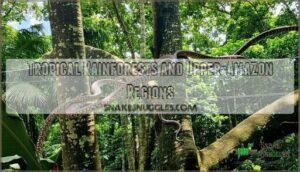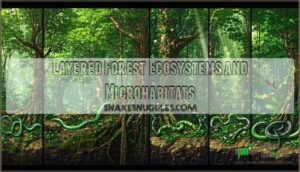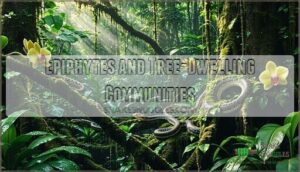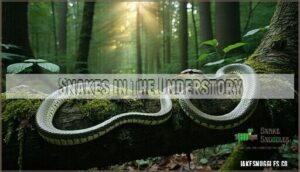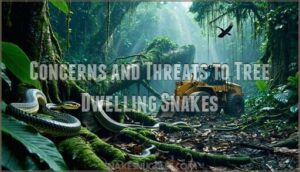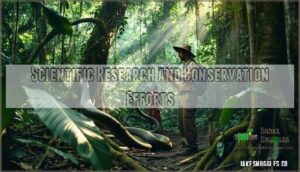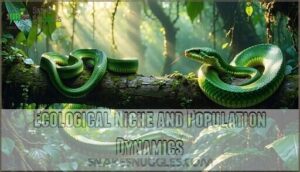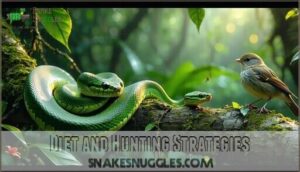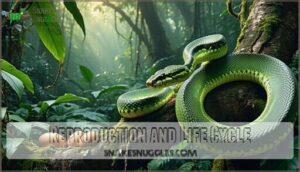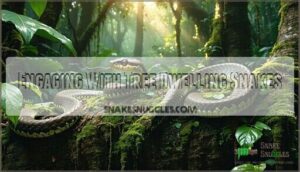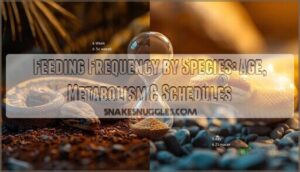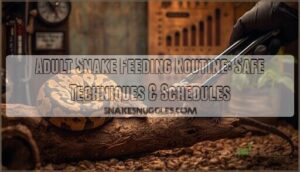This site is supported by our readers. We may earn a commission, at no cost to you, if you purchase through links.

Their slender bodies navigate narrow twigs while specialized scales provide traction on smooth bark. Green tree pythons and emerald tree boas exemplify this lifestyle, using heat-sensing pits to detect warm-blooded prey moving through the canopy.
Many species display cryptic coloration that mimics leaves, bark, or dappled sunlight, making them nearly invisible to both predators and prey. The canopy’s complex structure creates countless microhabitats, from vine tangles to epiphyte gardens, each supporting different snake species with unique hunting strategies and dietary preferences.
Table Of Contents
- Key Takeaways
- Tree Dwelling Snakes
- Canopy Habitats
- Snakes in The Understory
- Ambush Hunters and Tree-Dwelling Strategies
- Concerns and Threats to Tree Dwelling Snakes
- Scientific Research and Conservation Efforts
- Ecological Niche and Population Dynamics
- Species Spotlight: Green Tree Pythons
- Engaging With Tree Dwelling Snakes
- Frequently Asked Questions (FAQs)
- What is the arboreal snake habitat?
- What type of habitat do snakes live in?
- What do snakes use as shelter?
- What are snakes that live in trees called?
- What habitats do snakes prefer?
- Do snakes live in the understory of the rainforest?
- Do snakes live under trees?
- How do tree-dwelling snakes protect themselves from predators?
- Can tree-dwelling snakes be safely handled by humans?
- How do arboreal snakes survive winter temperatures?
- Conclusion
Key Takeaways
- You’ll find specialized adaptations that make tree-dwelling snakes masters of canopy life – their prehensile tails act like extra hands, laterally compressed bodies navigate narrow branches, and heat-sensing pits detect warm-blooded prey moving through the trees.
- You’re witnessing nature’s ultimate camouflage artists when you spot these serpents – their cryptic coloration perfectly mimics leaves, bark, and dappled sunlight, making them nearly invisible to both predators and prey in their three-dimensional world.
- You’ll discover that habitat destruction poses the greatest threat to these remarkable reptiles – deforestation, mining, pollution, and climate change are fragmenting their canopy homes faster than researchers can study them, with some populations declining by 75% in fragmented forests.
- You can contribute to conservation efforts through citizen science projects, responsible wildlife tourism, and supporting educational programs that track snake populations, with platforms like iNaturalist already documenting over 15,000 arboreal snake sightings since 2018.
Tree Dwelling Snakes
You’ll find tree dwelling snakes have evolved remarkable adaptations that let them thrive in the three-dimensional world of forest canopies.
These serpents possess specialized features like prehensile tails, laterally compressed bodies, and camouflage patterns that make them masters of arboreal life.
Nature’s ultimate acrobats, these serpents turn tree branches into highways with their remarkable climbing abilities.
Definition and Characteristics
Through the dense canopy, you’ll discover tree dwelling snakes that have mastered life above ground.
These arboreal reptiles showcase incredible Snake Morphology with elongated bodies perfectly suited for forest ecosystem navigation.
- Streamlined Bodies: Long, slender frames with specialized angled scales enhance Tree Climbing abilities
- Adaptive Coloration: Green and brown Camouflage Strategies help them blend seamlessly with leaves and bark
- Habitat Specialization: Tropical rainforest canopy habitats provide the humidity and warmth these species need to thrive
Arboreal Adaptations
Tree dwelling snakes showcase remarkable arboreal adaptations that facilitate canopy survival.
Their scale structure provides enhanced branch grip, while specialized anatomy enables efficient tree climbing.
These forest ecosystem inhabitants display sophisticated camouflage patterns that blend seamlessly with foliage.
Arboreal reptiles have evolved unique body proportions and muscle configurations for traversing three-dimensional canopy habitats with precision and stealth.
Arboreal Adaptation Snake Species
Prehensile Tails and Gripping Feet
Beyond their remarkable flexibility, arboreal snakes possess specialized prehensile tails that function like an extra hand for traversing treetops.
These serpents transform branches into highways, using their tails as nature’s ultimate climbing tool.
These muscular appendages wrap around branches with incredible precision, while modified scales provide enhanced grip.
Key adaptations include:
- Tail Anatomy: Muscular vertebrae create powerful coiling strength for branch anchoring
- Foot Structure: Specialized scales with micro-ridges increase surface friction on bark
- Climbing Mechanics: Coordinated tail-body movement allows seamless vertical navigation
This snake balance system transforms canopy habitats into highways, enabling efficient hunting and territorial movement through complex arboreal environments.
Camouflage and Hunting Strategies
You’ll discover how camouflage patterns create nearly invisible predators in the canopy.
These ambush hunters use stealth methods to remain motionless for hours, blending perfectly with bark and leaves.
Their coiled hunting positions conserve energy while prey detection relies on heat signatures and movement.
Advanced ambush techniques make them supremely effective nocturnal predators.
Canopy Habitats
You’ll find that canopy habitats create perfect three-dimensional hunting grounds where arboreal snakes can approach prey from above, below, or alongside branches.
These complex forest layers provide the temperature variation, humidity levels, and structural support that tree-dwelling species need to thrive in their elevated world, which is a key aspect of arboreal environments.
Tropical Rainforests and Upper-Amazon Regions
You’ll find the world’s richest Rainforest Ecology in tropical rainforests and Upper-Amazon regions, where over 70 arboreal snake species call the canopy home.
These Amazon Biodiversity hotspots support complex Forest Dynamics, with tree dwelling snakes occupying heights between 10-30 meters.
The tropical rainforest canopy maintains 85% humidity and temperatures fluctuating between 24-32°C, creating perfect conditions for canopy habitats.
- Ancient homes crumble as deforestation claims 3 million hectares annually
- Indigenous guardians battle to protect ancestral lands from destruction
- Climate chaos disrupts the forest ecosystem’s delicate balance
Layered Forest Ecosystems and Microhabitats
From the Amazon’s towering giants to New Guinea’s dense canopies, you’ll discover how forest structure creates distinct zones where tree dwelling snakes thrive.
Each canopy layer supports different species through microclimate variation and unique ecosystem services. The complexity of these ecosystems is also influenced by various snake habitat types.
| Forest Layer | Height (meters) | Snake Species | Microhabitat Features | Temperature Range |
|---|---|---|---|---|
| Emergent | 45-60 | Few specialists | Direct sunlight, wind exposure | 25-35°C |
| Canopy | 20-45 | Green tree pythons | Dense foliage, stable branches | 22-28°C |
| Understory | 5-20 | Vine snakes | Filtered light, high humidity | 20-25°C |
| Shrub | 1-5 | Young arboreal species | Protected, moderate light | 18-24°C |
| Forest Floor | 0-1 | Terrestrial species | Deep shade, leaf litter | 16-22°C |
These layered forest ecosystems create perfect microhabitats where tree diversity determines available niches, making canopy habitats incredibly complex three-dimensional environments.
Epiphytes and Tree-Dwelling Communities
Within the canopy’s vertical neighborhoods, epiphytes create living apartments on tree branches.
These air plants—orchids, bromeliads, and ferns—transform bare bark into bustling communities.
Tree dwelling snakes navigate this three-dimensional maze, hunting among the epiphyte gardens where frogs hide in bromeliad pools and lizards dart between leafy shelters.
This forest structure offers countless microhabitats for arboreal interactions, creating a complex environment that supports a wide range of species, including those that live in bromeliad pools.
Snakes in The Understory
While you might picture snakes lounging in the high canopy, many species actually call the understory home, where they’ve mastered life in the forest’s shadowy middle layer.
These understory specialists have developed remarkable adaptations for hunting and surviving in environments where sunlight barely penetrates and every branch could hide either prey or predator.
Forest Floor and Understory Layer
The forest floor bustles with snake species perfectly adapted to this shadowy domain.
These Floor Dwellers navigate through Leaf Litter and dense Understory Habitat with remarkable precision.
Forest Ecology creates three distinct microenvironments that support diverse snake communities:
- Decomposing leaf layers – providing cover and hunting grounds for small constrictors
- Root systems and Snake Burrows – offering shelter from predators and temperature extremes
- Fallen logs and debris – creating highways for ground-dwelling species
This complex forest ecosystem supports snakes that rarely venture into canopy habitats above.
Snakes That Live Under Trees
Below the towering canopy, understory life thrives in shadowy domains where tree dwelling snakes navigate forest floors with remarkable skill.
These serpents have mastered living among tree roots and dense vegetation.
- Burrowing species like African rock pythons slither through leaf litter, creating snake hides beneath fallen logs and debris.
- Live-bearing snakes give birth to young in protected understory niches, avoiding canopy risks.
- Gliding snakes use branch ecology to swoop between understory levels in tropical rainforest environments.
Adaptations for Low-Light Environments
Beyond the trees’ protective canopy, you’ll find tree dwelling snakes equipped with remarkable sensory adaptations for low light environments.
These arboreal snakes use pupil dilation and enhanced low light vision to spot prey in shadows.
Heat sensing organs detect warm-blooded targets, while specialized nocturnal behavior patterns maximize hunting success when darkness falls across canopy habitats.
Ambush Hunters and Tree-Dwelling Strategies
You’ll witness arboreal snakes using incredibly sophisticated hunting techniques that transform them into living weapons hidden in the canopy.
These masters of disguise rely on heat-sensing abilities and chemical detection to locate prey, then coil their bodies like loaded springs ready to strike with lightning precision.
Hunting Techniques and Prey Capture
Mastering the art of hunting requires precision and patience for these arboreal predators.
Tree-dwelling snakes employ sophisticated ambush tactics and prey selection strategies that make them incredibly effective hunters in their vertical world.
Key hunting strategies include:
- Ambush tactics – Remaining motionless for hours, perfectly positioned along branches where prey frequently travels
- Prey selection – Targeting birds, small mammals, and lizards based on size, vulnerability, and energy requirements
- Camouflage methods – Using natural coloration and body positioning to blend seamlessly with bark and foliage
Use of Scent and Heat Signatures
You’ll find that arboreal snakes excel at scent detection and heat sensing for prey tracking.
Their forked tongues collect chemical information while specialized pit organs detect heat signatures from warm-blooded prey.
This dual sensory system makes thermal imaging incredibly effective in dense canopy environments.
Snake ecology shows these ambush tactics work perfectly for tree dwelling snakes hunting birds and mammals above ground.
Coiled and Uncoiled Hunting Positions
Energy-efficient hunting postures define arboreal snake success.
You’ll observe these predators switching between coiled and uncoiled positions strategically. Coiled hunting maximizes coil strikes while conserving energy—snakes remain motionless for hours.
Uncoiled hunting allows extended reach along branches.
These ambush tactics by tree dwelling snakes facilitate successful prey capture through calculated positioning in the snake canopy.
Concerns and Threats to Tree Dwelling Snakes
You’ll face significant challenges protecting these remarkable arboreal species as human activities increasingly threaten their canopy homes.
Habitat destruction through deforestation, mining pollution, and climate change create a perfect storm that’s pushing many tree-dwelling snakes toward extinction faster than researchers can study them, which is a result of human activities and habitat destruction.
Habitat Destruction and Fragmentation
Through widespread deforestation and ecosystem disruption, tree dwelling snakes face unprecedented threats to their survival.
Habitat destruction fragments canopy habitats, isolating populations and reducing genetic diversity.
- Deforestation Impact: Over 17% of Amazon rainforest lost in 50 years
- Habitat Loss: Southeast Asia lost 32 million hectares of primary forest
- Fragmentation Effects: Snake populations drop 75% in fragmented forests
Conservation strategies must prioritize habitat preservation to protect these specialized canopy dwellers. Understanding snake habitat destruction is vital for developing effective conservation plans.
Mining Operations and Pollution
Mining operations devastate arboreal snake habitats through toxic runoff and habitat destruction.
You’ll find these industrial activities create a deadly cocktail of chemical pollution and deforestation that fragments snake populations across tropical canopies.
| Mining Impact | Effect on Snakes | Recovery Time |
|---|---|---|
| Toxic Runoff | Contaminated water sources | 5-10 years |
| Habitat Loss | Population fragmentation | 15-25 years |
| Pollution Effects | Reduced prey availability | 3-7 years |
| Ecological Damage | Disrupted breeding cycles | 10-15 years |
The table outlines the specific mining impact on snake habitats, including toxic runoff, habitat loss, and pollution effects, which all contribute to the decline of these species.
Climate Change and Rising Temperatures
Temperature shift threatens tree dwelling snakes as climate change pushes these canopy specialists beyond their thermal tolerance limits.
Rising temperatures create ecosystem disruption that fragments forest habitats and alters prey availability patterns.
Climate modeling reveals devastating impacts:
- Range contractions – Species lose 30% of suitable habitat by 2100
- Reproductive failure – Embryonic survival drops 22% above 32°C
- Metabolic stress – Heat reduces activity periods by 31%
- Disease outbreaks – Fungal infections surge in warming canopies
- Prey collapse – Arthropod populations decline 15-30% annually.
Rising oceans compound these threats, making forest ecosystem conservation essential for arboreal snake survival.
Scientific Research and Conservation Efforts
Scientists use advanced technology and collaborative approaches to study arboreal snakes in their challenging canopy environments.
You’ll find researchers employing camera traps, direct observation techniques, and community partnerships to understand these elusive predators and protect their forest homes, using collaborative approaches.
Studying The Canopy and Tree-Dwelling Snakes
Following decades of habitat loss, researchers have developed sophisticated methods to study canopy ecology and snake behavior in these vertical ecosystems.
You’ll find scientists using canopy access techniques like rope climbing and tower cranes to observe arboreal snakes in their natural forest structure habitat. The use of advanced canopy access systems has substantially improved the accuracy of observations.
| Research Method | Primary Focus | Key Findings |
|---|---|---|
| Radio Telemetry | Movement patterns of tree dwelling snakes | 80% of time spent above ground |
| Genetic Studies | Population connectivity in forest canopy | Fragmentation reduces gene flow |
| Field Observations | Arboreal ecology and hunting behavior | Vertical zoning influences distribution |
| Long-term Monitoring | Snake ecology population trends | 30% decline in some regions |
| Canopy Access Systems | Direct observation of arboreal snakes | New species discoveries ongoing |
The table highlights various research methods used to study arboreal snakes, including Radio Telemetry, Genetic Studies, and Canopy Access Systems, which have led to key findings such as 80% of time spent above ground and fragmentation reduces gene flow.
Camera Traps and Observational Methods
Camera Placement requires strategic positioning to maximize Trap Efficiency while minimizing Observational Bias.
You’ll need multiple units at varying canopy heights to capture complete snake behavior patterns.
Wildlife Monitoring systems with infrared sensors work best for nocturnal species detection.
Data Analysis reveals movement patterns that traditional observational studies miss.
These snake research methods provide continuous forest canopy surveillance without human interference, revolutionizing our understanding of arboreal snake ecology.
Collaborative Conservation Initiatives
Conservation partnerships create powerful alliances that protect tree dwelling snakes and their canopy habitats.
You’ll discover that combining resources with researchers, NGOs, and local communities strengthens wildlife preservation efforts substantially.
These collaborative conservation initiatives tackle habitat destruction while building lasting species protection networks.
- Community engagement programs educate locals about snake conservation importance and economic benefits
- Habitat restoration projects rebuild degraded canopy ecosystems through native tree planting initiatives
- Multi-organization partnerships pool expertise from wildlife conservation groups, universities, and government agencies
- Citizen science networks train volunteers to monitor snake populations and report habitat changes
Effective conservation also relies on understanding water rights management to preserve habitats.
Ecological Niche and Population Dynamics
You’ll find that arboreal snakes have carved out remarkably specific niches within forest canopies, with each species occupying distinct vertical zones and prey preferences to minimize competition.
These population dynamics create fascinating ecological webs where emerald tree boas might dominate the mid-canopy while green tree pythons claim the upper reaches, their numbers fluctuating based on prey availability and habitat quality.
Competition and Resource Partitioning
Competition naturally shapes how tree-dwelling snakes share forest resources.
When species coexist, they develop resource partitioning strategies to reduce direct competition.
Green tree pythons hunt mammals at night, while emerald tree boas target birds during dawn hours.
This niche partitioning prevents habitat sharing conflicts, allowing species coexistence through different hunting schedules and prey preferences, creating stable competition models within canopy ecosystems.
Predator-Prey Relationships and Trophic Cascades
Arboreal snakes shape forest ecosystems through complex predator-prey relationships and trophic cascades.
When you remove these apex predators, prey populations explode, creating ripple effects throughout food webs.
Their presence maintains ecosystem balance by controlling bird, lizard, and small mammal numbers.
- Witnessing nature’s domino effect when snake populations decline
- Feeling the forest’s pulse change as prey behaviors shift
- Observing the delicate dance between predator and prey species
- Experiencing ecosystem disruption when biodiversity loss occurs
- Understanding your role in protecting these essential predator-prey relationships
Population Size and Distribution Patterns
Most tree-dwelling snakes face shrinking populations due to habitat fragmentation that breaks up their geographic range.
Population density varies dramatically—some species thrive in dense clusters while others spread thinly across vast territories.
Distribution maps reveal concerning population trends: species abundance drops substantially in logged areas.
Understanding these geographic range patterns helps scientists target conservation efforts where snake populations need protection most.
Species Spotlight: Green Tree Pythons
When you encounter a green tree python in the wild, you’re witnessing one of nature’s most perfectly adapted arboreal predators.
These emerald-colored serpents have mastered life in the canopy with their remarkable heat-sensing abilities and lightning-fast strikes that can catch prey off guard in seconds.
Habitat and Distribution
Green tree pythons call the lush tropical rainforests of New Guinea, eastern Indonesia, and northeast Australia home.
You’ll find these arboreal snakes traversing dense canopy habitats where Forest Ecology thrives.
Their distribution spans regions where rainforest conservation efforts protect essential tree canopy ecosystems from habitat loss.
- Primary range: New Guinea’s pristine rainforests and bamboo thickets
- Australian habitat: Cape York Peninsula’s monsoon forests
- Indonesian islands: Various forested regions with dense vegetation
- Elevation preference: Sea level to 1,500 meters in tropical zones
Diet and Hunting Strategies
When you observe these ambush hunters in action, you’ll notice their incredible hunting prowess.
Green tree pythons use sophisticated prey selection methods, targeting small mammals, birds, and reptiles through heat-detecting labial pits.
Their ambush strategies involve patient waiting while their snake camouflage patterns blend seamlessly with foliage.
These snake hunting strategies include tail-luring—wiggling their bright tail tip to attract curious prey within striking distance.
Reproduction and Life Cycle
Beyond their hunting prowess, green tree pythons follow fascinating reproductive patterns that showcase nature’s precision.
These snake reproduction cycles demonstrate remarkable efficiency:
- Mating Habits: Sexual maturity arrives at 2 years, with females selecting multiple partners during breeding seasons
- Egg Incubation: Clutch size ranges from 5-35 eggs, requiring 45-56 days of careful temperature regulation
- Reproductive Age: Life span extends 20-30 years, allowing numerous breeding opportunities throughout their arboreal existence
Females sacrifice feeding during gestation, relying entirely on stored energy reserves.
Engaging With Tree Dwelling Snakes
You can connect with arboreal snakes through educational programs that teach you about their unique adaptations and conservation needs.
Citizen science projects let you contribute to research while responsible ecotourism offers glimpses of these remarkable canopy dwellers in their natural habitats.
Educational Programs and Outreach
Educational programs reveal snake conservation’s potential through hands-on learning experiences. Wildlife outreach transforms fear into fascination when participants observe live demonstrations and interactive exhibits. Community engagement flourishes through school partnerships and nature center collaborations.
| Program Type | Target Audience | Key Activities |
|---|---|---|
| School Visits | Students K-12 | Live snake demonstrations, habitat models |
| Nature Centers | General Public | Interactive exhibits, guided tours |
| Community Events | Local Residents | Snake safety workshops, conservation talks |
| Online Platforms | Global Audience | Virtual tours, educational videos |
Conservation education builds environmental awareness through storytelling and scientific facts. Public awareness campaigns dispel myths while highlighting arboreal snakes’ ecological importance. Snake education programs create lasting connections between people and wildlife, fostering tomorrow’s conservationists. By adopting snake friendly practices, individuals can contribute to the well-being of these animals and their ecosystems.
Citizen Science and Community Involvement
You can make a real difference by joining citizen science projects that track tree dwelling snakes in canopy habitats. Your smartphone photos and observations help researchers map species distributions and monitor population trends.
Community involvement through platforms like iNaturalist has already contributed over 15,000 arboreal snake sightings since 2018, directly supporting conservation efforts. The use of science apps tools has been instrumental in facilitating this process.
Volunteer research opportunities include:
- Citizen projects like the Amazon Tree Boa Project, where community engagement provides 60% of new locality records
- Public awareness campaigns that train volunteers in safe identification techniques across multiple languages
- eDNA sampling programs that boost snake detection rates by 40% in rainforest regions
Your contributions to conservation efforts help protect these remarkable canopy specialists for future generations.
Responsible Wildlife Tourism and Viewing Practices
When you explore tree dwelling snakes through sustainable tourism, you’re supporting wildlife conservation while witnessing nature’s masterpiece.
Choose eco friendly operators who practice responsible viewing techniques—maintaining safe distances from arboreal snakes and their canopy habitats.
Your environmental ethics matter: observe quietly, don’t disturb nests, and support local guides who understand these remarkable creatures’ behaviors and needs.
By working with eco tourism operators, you can promote conservation efforts and guarantee a positive impact on the environment.
| Viewing Practice | Distance Required | Best Time |
|---|---|---|
| Python observation | 10+ feet away | Dawn/dusk |
| Boa photography | 15+ feet away | Early morning |
| Viper encounters | 20+ feet away | Nighttime |
Frequently Asked Questions (FAQs)
What is the arboreal snake habitat?
Imagine this: you’re climbing through layers of green mystery, discovering where these serpentine acrobats call home.
You’ll find arboreal snakes thriving in tropical rainforests, where dense canopy structures provide interconnected branches for climbing, hunting, and shelter within humid, warm microhabitats.
What type of habitat do snakes live in?
Snakes inhabit diverse environments worldwide, from tropical rainforests and deserts to grasslands and wetlands.
You’ll find them in underground burrows, tree canopies, rocky crevices, and aquatic habitats, adapting to virtually every ecosystem except Antarctica.
Snakes inhabit diverse environments worldwide.
What do snakes use as shelter?
Consider a green tree python coiled inside a hollow tree trunk during monsoon season.
You’ll find snakes using diverse shelters: rock crevices, logs, burrows, leaf litter, and abandoned animal dens.
They’re opportunistic, choosing spots that offer protection from predators and weather.
What are snakes that live in trees called?
You’ll encounter arboreal snakes when you look up into tree canopies. These tree-dwelling species have evolved prehensile tails and slender bodies to navigate branches with remarkable grace and precision.
What habitats do snakes prefer?
Like a master key opening countless doors, you’ll find snakes adapting to diverse habitats worldwide.
They thrive in tropical rainforests, deserts, grasslands, wetlands, and even urban areas, choosing environments that match their thermal needs and prey availability.
Do snakes live in the understory of the rainforest?
Yes, you’ll find several snake species thriving in the rainforest understory.
Forest floor and understory layers host burrowing and gliding snakes that’ve adapted to low-light environments through enhanced heat sensing and pupil dilation.
Do snakes live under trees?
You’ll find snakes beneath trees in many habitats.
Ground-dwelling species like garter snakes, rat snakes, and copperheads shelter under fallen logs, leaf litter, and tree roots for protection and hunting opportunities.
How do tree-dwelling snakes protect themselves from predators?
A green tree python coils motionless among leaves, its emerald scales perfectly mimicking foliage.
You’ll find these snakes use camouflage, freeze responses, and prehensile tails to escape predators while traversing canopy dangers, utilizing their prehensile tails for stability.
Can tree-dwelling snakes be safely handled by humans?
You shouldn’t handle tree-dwelling snakes without proper training. They’re wild animals with defensive bites, venom, or constricting abilities. Even "harmless" species can carry diseases or cause injuries when stressed.
How do arboreal snakes survive winter temperatures?
Something’s lurking in the cold… While their cousins face winter’s harsh reality, you’ll find arboreal snakes entering brumation, becoming lethargic as their metabolism slows tremendously.
They’ll seek sufficiently insulated environments for survival. During this period, snakes often rely on snake brumation strategies to conserve energy, which is a crucial aspect of their brumation process, helping them survive through the cold seasons with minimal energy.
Conclusion
Scientists have long debated whether tree dwelling snakes canopy habitats represent nature’s most sophisticated arboreal ecosystem, and the evidence strongly supports this theory.
You’ll discover that these remarkable reptiles have transformed rainforest canopies into complex three-dimensional hunting grounds through millions of years of evolution.
Their specialized adaptations—from prehensile tails to heat-sensing pits—demonstrate nature’s incredible ability to fill every available niche.
Understanding these adaptations helps you appreciate the delicate balance that sustains these extraordinary ecosystems.
- https://www.snakescapes.com/post/arboreal-snake-habitats-designing-elevated-environments-for-tree-dwelling-snakes
- https://lazoo.org/explore-your-zoo/our-animals/reptiles/green-tree-python/
- https://animalia.bio/brown-tree-snake?taxonomy=956
- https://livingrainforest.org/learning-resources/emerald-tree-boa
- https://pubmed.ncbi.nlm.nih.gov/17479754/

